Seapost -> The Devonport Cape Packet Mark
The Devonport Cape Packet Mark
By Mike Dovey
The first Devonport Cape Packet cancellation was used in December 1857 when a contract had been agreed between the Post Office and the Union Line Shipping Company. The Union Line had originally been a coaling company supplying coal to ships of the P & O and Royal Mail Lines at Southampton under the name of the Southampton Steam Shipping Company, being formed in 1853. However the five ships they owned were quickly taken over by the British Government to supply the troops in the Crimea in 1854. When that war ended in 1855 all the ships were surplus to requirements in their old task because of a surplus of coal stocks, so fresh routes had to be found. Voyages to South America proved fruitless so in 1857 the board of the company changed the name to Union Line and a contract was agreed with the Post Office for a monthly sailing to the Cape with a voyage not exceeding 42 days. For this they would receive a payment of £33,000 per annum.
The sailings were to be from Plymouth to Capetown, or in bad weather, to Simonstown (formally Symons Bay), South Africa. This service continued from the first voyage by the MV Dane on the 15th September 1857 until 1870 when the whole operation was moved to Southampton in order to cut costs and hopefully earn more revenue following the severe fall in trade around the Cape owing to the opening of the Suez Canal in 1869.

The four cancels (Robertson1 types P3 – P6) were in use at Devonport from December 1857 until 1870 and little is known about which ones were used in what period of the 13 years they were in service.
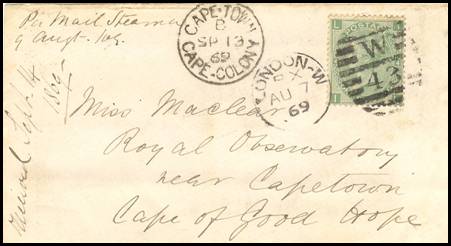
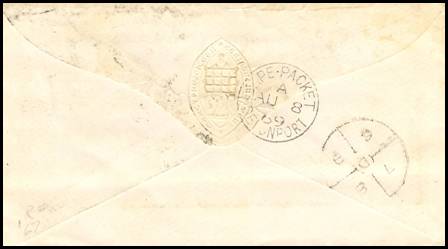
Figure 1. P6 Dated 1869 towards the very end of the usage period together with the Robertson type M1 quartered circle bagging stamp.
Figure 1 shows the P6 cancel used towards the end of the era on an envelope posted in London on the 7th August 1869 and leaving Devonport the following day to arrive in Capetown on the 13th September. The 1/- stamp is obliterated by a London W43 mark. The quartered circle cancel is believed to have been used only on the Cape Packet voyages either on its own or in conjunction with a Cape Packet cancel and is known used from 1865 until 1869. The mark was applied to letters (or possibly just the back of the last letter in a bundle) sorted in the London Foreign Branch for the Cape Packet - "D" for Devonport2 .
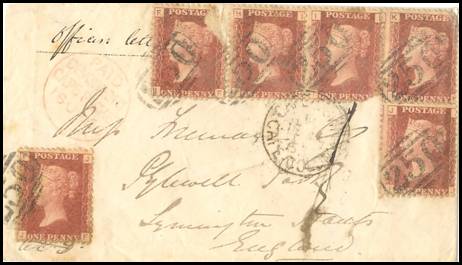
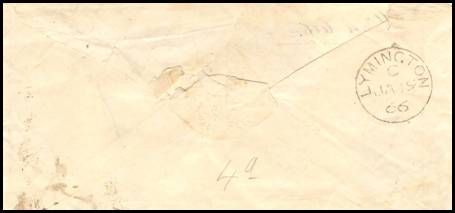
Figure 2. P5 Used from somewhere in South Africa via Capetown to England franked by 1d red stamps cancelled at Devonport.
Figure 2 shows a cover sent from Capetown back to Lymington, England, with a P5 Cape Packet cancel in red. The envelope was posted and passed through the Post Office at Capetown in December to arrive at Devonport on the 18th January 1866 (the code used at Devonport is 250) to arrive at its destination the following day. It is an "Officers letter" and therefore was, it is assumed, posted by an Officer in a regiment on duty somewhere in Africa, as Cape of Good Hope stamps had been available in Capetown since 1853 (the now famous Cape triangulars).
It was usual for anyone in the Army to be able to post letters using GB stamps. The mail would be bagged up and sent back to Great Britain where it would be opened and dealt with. What makes Figure 2 interesting is that it was franked using six 1d red stamps and then cancelled at Capetown on route for Great Britain. This makes the cover all the more desirable.
Post 1870 - Plymouth Cape Packet mark
In 1870 the Devonport Cape Packet marks ceased to be used, but two Plymouth Cape Packet marks, Robertson types P3 and P4 came into operation instead. In that year the Union Line, trading from the Cape, moved all of its operations from Plymouth to Southampton and so these two new marks were rarely used except for mails landed out of course by just a few ships still calling at Plymouth from South Africa prior to March 1874. This makes the marks, with one illustrated in figure 3, just a little rarer than the norm.
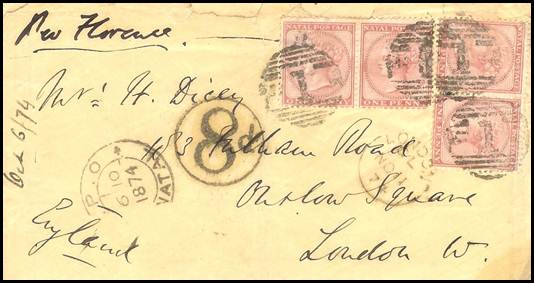
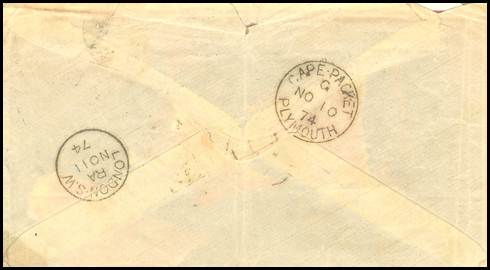
Figure 3. Cape Packet mark P3 of Plymouth on the reverse of this cover sent from Natal on 6th October 1874 to London, arriving November 11th .
Of additional interest is the circular '8d' postage due mark (Wilson 359d) on the front of the cover which was applied on board the Plymouth to Bristol TPO. This mark was originally issued to Devonport on 27th April 1868. It was probably transferred to the TPO with the Devonport staff about August/September 18693 along with other charge marks W359a-W359l. (This was initially to sort West Indies mail on the new TPO once sorting on board ship had been terminated in 1869. Sorting of South African mail on the TPO commenced soon after.)
The letter is endorsed 'per Florence'. The Florence (Currie Line) left Natal on 7th October 1874 and arrived Cape Town on 13th October, missing the Currie Atlantic sailing by Walmer Castle of 11th October. The letter was passed by the Cape Post Office to the Union Line and carried by the European on 16th October arriving at Plymouth on 10th November.
Plymouth was the normal port for Union incoming mails [again] from 25th March 1874. The Cape Packet Plymouth date-stamp was regularly used at this time.
Paid 4d in Natal assumed letter would be transferred to the Currie vessel at Port Elizabeth or Cape Town. Having missed the Currie transfer the letter was placed on a Union Packet, which was usual if a letter had been paid 1/- (the relevant packet rate). Delivery in the UK ex Union Packet, but paid 4d, should have been charged 1d. 8d. by current regulations (deficiency of 8d plus a fine of 1/-). It seems that the GPO accepted this was harsh in the circumstances and limited the charge to the amount of the underpayment. In similar circumstances there had been a public outcry in the press about charging the fine for underpayment.
Additional notes provided by John Dickson.
Related topics
See also South Africa Sea Post Office - Union Castle Ocean Post Offices and 1854 Plymouth Packet Letter from Mauritius.
References
[1] Tabeart, C: Robertson Revisited,
James Bendon Ltd, Limassol, Cyprus, 1997
[2] THE QUARTERED CIRCLE BAGGING STAMPS 1864-1900, M Scott Archer,
London Postal History Group
[3] Wilson, HW: Plymouth & Bristol TPO (Foreign Mails) Part 1, T.P.O Quarterly Journal of the TPO & Seapost Society, Volume 49, page 59, 1995

